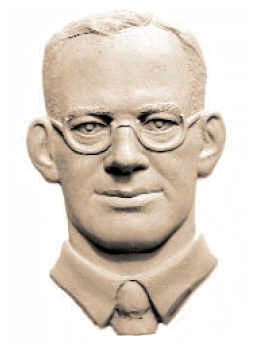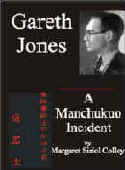Gareth Jones
[bas relief by Oleh Lesiuk]
HOME |
Stop Press |
Complete Soviet Articles & Background Information |
Précis of Gareth's
|
All Published Articles |
BOOKS
|
|
|
|
More Than Grain of Truth(2005) |
|
|
TOPICAL
'Are you Listening NYT?' U.N. Speech - Nov 2009 |
Gareth Recognised at Cambridge - Nov 2009 |
Reporter and the Genocide - Rome, March 2009 |
Order of Freedom Award -Nov 2008 |
Premiere of 'The Living' Documentary Kyiv - Nov 2008 |
Gareth Jones 'Famine' Diaries - Chicago 2008 |
Aberystwyth Memorial Plaque 2006 |
GENERAL
Scholarship Fund |
Site Map |
Links |
Legal Notices |
Sponsored Links |
Contact |
The New York Times. 25 June 1931
RED ARMY IS HELD AS NO MENACE TO PEACE
-----------------
Depicted as Purely Protective Organization and Likely to Remain So.
-----------------
EUROPE’S FEARS BELITTLED
-----------------
Talk of Horde Sweeping Forward to Conquest of World Called Anti-Soviet Propaganda.
-----------------
DEFENSE FORCE FORMIDABLE
-----------------
Foreign Attaches Admit Equality With Other Armies in Discipline, Training and Equipment.
This is the ninth of a series of articles on Russia today by The New York Times Moscow correspondent, who is at present in Paris.
By WALTER DURANTY.
Special Cable to The New York Times.
PARIS June 24.—In an earlier dispatch your correspondent explained how Stalinism was being propagated by all the resources of the press. radio and Communist party, from adults to little children. There is another factor, however, whose importance is a little less and in some respects is greater; namely, the Army and the drive -for civilian “training in defence” from Osoaviakhim or Soviet Air League, to the Workers Battalion of men, women and Communist youth and the Young Pioneer Volunteer Corps. A cognate phase of this movement is the inevitable growth of ‘nationalism” if it may be called that, although the Bolsheviki prefer the phrase ‘‘corporate spirit for defense of the Socialist fatherland." or something to that effect. This subject will be treated in the following article because the question “What is the true purpose of the Red Army and what is at the bottom of all this military training?” has more immediate interest.
Strength As Given by Soviet.
The Soviet always maintains that the Red Army, including the naval forces, does not surpass in peace time 650,000 men established on a territorial basis similar to that of Switzerland, which is a comparatively modest figure considering the size of the country’s population. The Soviet sometimes “points with pride” to the far smaller proportion of military expenditure in its national budget than that of its Baltic or Polish neighbors, which is true on paper but somewhat disingenuous, as the Soviet budget is enormously swelled by industry trade and construction in the hands of the State.
There is a question, too, whether the so-called special or “Thcheka Battalions,” long-term volunteer troops which form the garrisons of the principal cities and the railroad and frontier guards to the number of upward of 150,000 are reckoned in the 650,000 above mentioned, the writer personally is inclined to believe not and to regard these troops as corps d’élite that might either be shock forces in a foreign war or provide officers and non-coms for the semi-trained “Citizen Defence Corps” that would be called up if war were declared.
As far as spirit is concerned the Red Army is excellent and loyal to the régime. Conscripts enter 10 to 15 per cent Communist and leave on completion of service 45 to 55 per cent. Officers are 65 to 70 per cent Communist in all ranks and 95 to 97 in the higher grades. The special battalions probably average around 70 per cent Communists. The civilian corps consist of organized workers of strong Communist sympathies and adult or young Communists.
In discipline, training and equipment it is the opinion of foreign military attachés at Moscow that the Red Army compares favorably today with that of any nation in Europe although no doubt it is inferior to the crack divisions of the great powers. The Chinese Eastern Railroad affair shows the staff work to be of high order because though a comparatively slight operation from the purely military standard—that is armed opposition was more or less negligible was carried out on a big scale in difficult terrain with excellent co-ordination and without a hitch. Foreign military observers also emphasized the admirable organization of the really impressive military demonstration on May 1 last in the Red Square.
Counting fully trained reservists, it is thus apparent that the Soviet could put in the field in the event of war a front-line force of 2,500,000 to 3,000,000 men, with 10,000,000 or so semi-civilian volunteers behind them. That is true on Paper, but foreign attachés do not believe such immense bodies could be adequately supplied in present circumstances and that war would not see a front-line force of more than 1,000,000 all told, and even then there would be difficulty about transport and an adequate supply of munitions.
Purpose of the Army.
As to the true purpose of the Red Army and the whole gigantic scheme of military preparation, your correspondent is prepared to stake his reputation on the fact that at present it is purely defensive, and for all he can see now will be so in the future. Europe’s nightmares of a “Red horde” sweeping forward to world conquest are, in this correspondents opinion, either anti-Soviet propaganda tout court or atavistic bogies of Attila, Tamerlane and the Turks.
Previous dispatches have shown, or tried to show, how “self-contained” Stalinism is and how thoroughly it has adopted Voltaire’s advice to “cultivate your own garden.” The Soviet’s garden is big enough and rich enough in all conscience to be worth cultivating; but one must never forget that the Bolsheviki themselves are still haunted by their own bogey of capitalist intervention, and whether one hates the Bolsheviki or approves to them or is wholly indifferent. It cannot be denied that the years 1918 and 1920 gave them certain ground for misgivings on the subject.
© The New York Times. 1931. N.B. The executive editor of The New York Times, Bill Keller, told The Washington Post on October 23 2003, that the newspaper would have no objection if the Pulitzer Prize Board wanted to revoke Mr. Duranty's award. Mr. Keller called Mr. Duranty's work "pretty dreadful. ... It was a parroting of propaganda." It will be taken as read that no royalties are due on this un-authorised reproduction of this article As such they are also perceived, as having no truthful value whatsoever, are only reproduced for academic and educational purposes, not intended to defraud The New York Times of any morally legitimate royalty revenue and are published without financial gain. In any event, the copyright for the above may well only reside, 70 years after its publication with the heirs of Walter Duranty, and with whom we have no personal animosity whatsoever. Nevertheless, any contention of copyright violation may by taken up under the jurisdiction of English Law. My service address for any legal correspondence is: Nigel Linsan Colley, 1, Crown Street, Newark, Nottinghamshire, England, NG24 4UY. Any prosecution will, you can be assured, be defended in the public domain.
|
|
|
|



